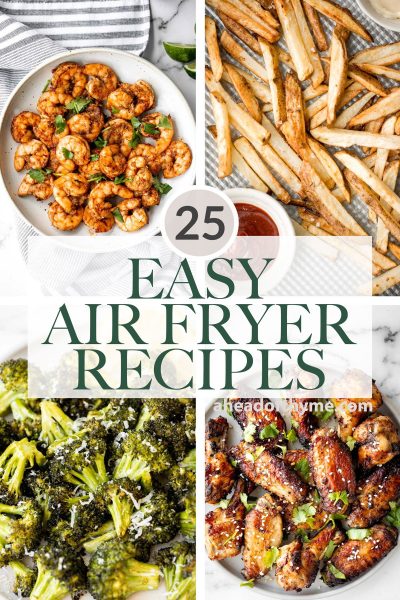In this article, you’ll discover the ultimate secret to achieving deliciously seasoned food for air frying.
Whether you’re a seasoned air fryer pro or just starting, finding the perfect way to add flavor to your dishes can make all the difference.
From exploring the ideal seasoning techniques to uncovering the best seasonings, get ready to elevate your air frying game and satisfy your taste buds with every bite.
So please sit back, relax, and let’s uncover the tasty secrets of seasoning for air frying together.
Choosing the Right Seasonings
Consider the Type of Food
When it comes to seasoning food for air frying, the first step is to consider the type of food you will cook. Different foods have different flavor profiles and require specific seasonings to bring out their best taste.
For example, if you’re cooking chicken, you may want to use seasonings that complement its natural flavor, such as garlic, herbs, and paprika. On the other hand, if you’re cooking vegetables, you might opt for lighter seasonings like lemon zest, herbs, and a touch of salt.
Experiment with Different Flavor Profiles
Air frying allows you to experiment with different flavor profiles and get creative in the kitchen. Don’t be afraid to try new combinations of seasonings to find what works best for your taste buds.
For instance, try a spicy rub with cayenne pepper and paprika for a kick, or go for a more savory blend with garlic powder, onion powder, and Italian seasoning. The possibilities are endless, and finding your favorite flavor combinations can take your air frying game to the next level.
Balance Sweet, Salty, Sour, and Spicy Flavors
A key aspect of seasoning food for air frying is balancing flavors. The ideal seasoning should have a combination of sweet, salty, sour, and spicy elements. This helps to create a harmonious taste profile that will enhance the overall flavor of your dish.
Adding a touch of sweetness with ingredients like honey or brown sugar, balancing it with salt, adding tanginess with citrus zest or vinegar, and incorporating a hint of spiciness with cayenne pepper or chili powder can take your air-fried meals to new heights of deliciousness.
Exploring Individual Seasonings
Salt and Pepper
Salt and pepper are the most basic and widely used seasonings in cooking, and they are no exception when it comes to air frying. Salt enhances the natural flavor of ingredients and helps create a crispy texture, while pepper adds a subtle heat that complements a wide range of dishes. These two staples should be the foundation of any seasoning blend you create for your air-fried meals.
Garlic Powder
Garlic powder is a versatile seasoning that adds a rich, savory flavor to your dishes. It pairs exceptionally well with meats, vegetables, and even potatoes. The great thing about garlic powder is that it distributes evenly and sticks to the food during the air frying process, ensuring every bite is packed with delicious garlicky goodness.
Onion Powder
Like garlic powder, onion powder adds a savory and slightly sweet flavor to your dishes. It works exceptionally well with meats, roasted vegetables, and stir-fried dishes. Onion powder can be used on its own or combined with other seasonings to add depth and complexity to your air-fried creations.
Paprika
Paprika is a spice made from ground-dried peppers. It comes in various varieties, including sweet, smoked, and hot. The choice of paprika depends on the level of heat and smokiness you desire in your dish. Sweet paprika adds a mild and slightly sweet flavor, while smoked paprika imparts a smoky aroma that works well with meats and vegetables. On the other hand, hot paprika adds a fiery kick for those who enjoy a spicy flavor profile.
Cayenne Pepper
If you like your food to have a bit of heat, cayenne pepper is the perfect seasoning for you. It adds a spicy kick to your air-fried dishes, making them extra flavorful and exciting. Just a pinch of cayenne pepper can elevate the taste of your favorite recipes, such as chicken wings, fries, or even roasted vegetables. Remember to use it sparingly if you’re not accustomed to spicy food.
Italian Seasoning
Italian seasoning blends dried herbs such as oregano, basil, thyme, and rosemary. This versatile seasoning adds a burst of Mediterranean flavors to your air-fried dishes. It pairs well with various ingredients, from chicken and fish to vegetables and pasta dishes. Incorporating Italian seasoning into your air frying repertoire can give your meals a taste of la dolce vita.
Curry Powder
Curry powder is a spice blend typically containing a mixture of turmeric, coriander, cumin, and other spices. It adds a warm and aromatic flavor to your dishes, delivering a taste of exotic cuisines. Whether you’re air frying chicken, vegetables, or tofu, a sprinkle of curry powder can transform your ordinary meals into extraordinary culinary delights.
Herbs
Fresh or dried herbs are a must-have for seasoning food for air frying. They add freshness, fragrance, and depth of flavor to your dishes. Popular herbs commonly used in air frying include rosemary, thyme, basil, and parsley. Whether using them individually or in combination, herbs can elevate the taste of your air-fried creations and transport you to a culinary paradise.
Citrus Zest
Adding zest from citrus fruits like lemons, limes, oranges is a fantastic way to brighten the flavor of your air-fried dishes. The zest contains essential oils that impart a refreshing and tangy taste to your meals. Sprinkle some citrus zest over your air-fried fish or chicken, and you’ll be greeted with a burst of vibrant flavors that will make your taste buds dance with joy.
Sesame Seeds
Sesame seeds are a popular ingredient in Asian cuisine and can add a nutty, toasty flavor to your air-fried dishes. They can be toasted beforehand and sprinkled over food just before serving to enhance your meal’s taste and visual appeal. Whether cooking up a stir-fry, making sesame chicken, or air frying vegetables, sesame seeds are an excellent addition to your seasoning arsenal.
Creating Flavorful Rubs
Understanding the Basics of Rubs
A rub is a blend of seasonings, herbs, and spices that are applied to the surface of the food before cooking. It helps to infuse flavor, enhance taste, and create a flavorful crust on the finished dish. Understanding the basics of rubs is crucial in order to maximize the flavor potential of your air-fried meals.
Building a Rub Recipe
Building a Rub recipe combines various seasonings and ingredients to create the desired flavor profile. There are endless possibilities when it comes to creating rubs for air frying. You can start with a simple combination of salt, pepper, and garlic powder, or get more complex with a blend of herbs, spices, and even a hint of sweetness. The key is to experiment and adjust the quantities of each ingredient until you find the perfect balance of flavors that suits your taste.
Dry vs. Wet Rubs
There are two main types of rubs: dry and wet. Dry rubs consist of a mixture of powdered seasonings, herbs, and spices, while wet rubs incorporate liquid ingredients such as oil, vinegar, or citrus juice to create a paste-like consistency. Both types of rubs can impart incredible flavors to your air-fried dishes, but they have slightly different effects.
Dry rubs create a flavorful crust on the food, while wet rubs help retain moisture and add a more intense flavor. Choose the type of rub that best complements the food you’re air frying and experiment with different combinations to find your favorite.
Allowing the Rub to Rest
After applying the rub to the food, it must rest for a certain period before air frying. This allows the flavors to penetrate and marinate the food, intensifying the taste. The length of the resting time depends on the type of food and the intensity of the flavors in the rub.
As a general rule, meat can benefit from resting in the refrigerator for at least 30 minutes to a few hours, while vegetables and seafood may only need 10-15 minutes. Be sure to follow the recommended resting times for optimal flavor infusion.
Marinating for Maximum Flavor
The Benefits of Marinating
Marinating is a technique that involves soaking food in a mixture of seasonings, liquids, and sometimes acids to tenderize and flavor it. Marinating enhances the taste of your air-fried dishes, helps lock in moisture, and creates a juicy and flavorful end product. It can transform simple ingredients into a culinary masterpiece.
Choosing the Right Marinade
When marinating for air frying, choosing the suitable marinade is crucial. A good marinade should complement the flavors of the food and enhance its natural taste. Common ingredients in marinades include oil, acid (such as citrus juice or vinegar), herbs, spices, and aromatics.
For meats, acidic marinades can help tenderize tough cuts, while flavorful oil-based marinades are great for vegetables, tofu, and fish. Consider the taste profile you want to achieve and select a marinade accordingly.
Marinating Times for Different Foods
The marinating time varies depending on the type and thickness of the food you’re air frying. Thicker cuts of meat generally require longer marinating times compared to smaller, more delicate items.
As a general guideline, poultry and seafood can benefit from 30 minutes to a few hours of marinating, while beef or pork can be marinated for several hours or even overnight. Vegetables and tofu often only need 15-30 minutes to absorb the flavors. Avoid marinating for too long, as the acid in the marinade can break down the proteins, resulting in a mushy texture.
Tips for Effective Marinating
To ensure effective marinating for air frying, there are a few tips to keep in mind. Firstly, always marinate in a non-reactive container such as glass or stainless steel to prevent any unwanted metallic flavors.
Secondly, ensure the food is fully submerged in the marinade to ensure even flavor distribution. If you’re marinating a large piece of meat, consider using a resealable plastic bag to minimize the marinade needed. Lastly, discard any leftover marinade that has come into contact with raw meat to avoid cross-contamination.
Using Oil for Enhanced Crispiness
Benefits of Using Oil
Oil is a fantastic way to enhance the crispiness and flavor of your air-fried dishes. Oil helps to promote browning, create a crispy texture, and prevent the food from sticking to the air fryer basket. It also aids in the even distribution of seasonings and can help to seal in moisture, especially when air frying lean proteins like chicken breast or fish fillets.
Types of Oils to Use
Choosing the right oil for air frying is essential. You’ll want to opt for oils with a high smoke point to prevent them from breaking down or producing harmful fumes during the cooking process. Some good options for air frying include vegetable oil, canola oil, grapeseed oil, avocado oil, and peanut oil. These oils are neutral in flavor and have high smoke points, making them suitable for air frying at higher temperatures.
How to Apply Oil for Optimal Results
Applying oil to your food before air frying can be done in a few ways. One method is to use a spray bottle filled with oil and lightly mist the food, ensuring an even coating. Alternatively, toss the food in a small amount of oil until it’s evenly coated. For foods that are more delicate or have an irregular shape, using a brush to apply the oil can be helpful. Regardless of your chosen method, remember that a bit of oil goes a long way, so use it sparingly to avoid excessive greasiness.
Alternatives to Oil
If you’re looking for alternatives to oil, there are a few options to consider. One option is to use cooking spray, a convenient and calorie-conscious way to achieve a similar effect to oil. Another alternative is to use a small amount of water or broth to help create steam and moisten the food during the air frying process. While these alternatives may not provide the same level of crispness as oil, they can still help enhance the flavor and texture of your air-fried dishes.
Applying Seasonings to Food
Properly Preparing Food for Seasoning
Before applying seasonings to your food, it’s essential to properly prepare it to ensure the best possible outcome. This includes washing and drying vegetables, patting meat dry, and removing excess moisture. Drying the food is crucial, as it allows the seasonings to stick better and promotes better browning and crispiness during the air frying process.
The Rule of Thumb for Seasoning
The rule of thumb for seasoning food is to start with a light coating and gradually add more if needed. It’s easier to add more seasoning later than to try to reduce the saltiness or spiciness of an over-seasoned dish. As you become more familiar with your air fryer and the flavor preferences of your household, you’ll develop a better sense of how much seasoning to use for different recipes.
Seasoning Techniques for Different Foods
Different foods require different seasoning techniques to ensure optimal taste and texture. When it comes to proteins like meats and seafood, it’s best to apply the seasonings directly to the surface of the food. For vegetables, tossing them in oil and seasonings or sprinkling them with a dry rub can help evenly distribute the flavors. Delicate items like fish fillets or shrimp can benefit from a light sprinkle of seasonings, while heartier cuts of meat can handle a more generous coating.
Layering Seasonings for Complex Flavors
To achieve complex flavors in your air-fried dishes, consider layering your seasonings. Start with a base seasoning like salt and pepper, then build upon it with complementary herbs, spices, or rubs. This layering technique allows each seasoning to shine individually while creating a harmonious blend that elevates the overall taste of your dish. Don’t be afraid to get creative and experiment with combinations to find your perfect flavor profile.
Tips for Air Frying Success
Preheating the Air Fryer
Preheating your air fryer is an essential step for achieving optimal results. Just like preheating an oven, preheating your air fryer ensures that the cooking chamber is hot and ready to go when you start cooking. This helps to promote even cooking and quicker cooking times. Preheat your air fryer according to the manufacturer’s instructions, usually for a few minutes before adding your food.
Applying Seasoning Before or During Cooking
When it comes to air frying, you can apply seasoning before cooking or add it during the cooking process. This choice depends on personal preference and the type of seasoning used. Dry rubs, herbs, and spices are best applied before cooking to allow the flavors to develop and meld with the food. Wet marinades or liquid seasonings can be added during cooking, especially if you want to create a sauce or glaze. Experiment with both methods to see which works best for your favorite recipes.
Avoiding Excessive Seasoning
While seasoning your food is essential for flavor, it’s crucial not to go overboard and use excessive seasoning. Adding too much salt or spices can overpower the natural flavors of your ingredients and result in a less enjoyable eating experience. Remember to start with a light hand and gradually add more if needed. Remember that it’s easier to add seasoning later than to remove excess seasoning once it’s been applied.
Take note of Cooking Time and Temperature.
When air frying your seasoned food, paying attention to cooking time and temperature is essential. Each recipe and food item will have specific guidelines, so it’s crucial to follow them for the best results. Cooking times and temperatures can vary depending on the size, thickness, and type of food you’re air frying. Keep a close eye on your dish as it cooks to prevent overcooking or undercooking, and use a kitchen thermometer to ensure meats are cooked to the desired internal temperature.
Considering Dietary Preferences and Restrictions
Using Low-Sodium Alternatives
If you’re watching your sodium intake, plenty of low-sodium alternatives are available to season your air-fried dishes. Opt for salt-free seasonings, herbs, and spices to enhance the flavors without adding extra sodium. You can also experiment with flavor enhancers like citrus zest, vinegar, or low-sodium soy sauce to add depth without the extra salt.
Exploring Salt-Free Seasonings
Salt-free seasonings are a fantastic option for those who want to limit their sodium intake without sacrificing flavor. These seasonings are usually made with herbs, spices, and other flavorful ingredients. Look for salt-free seasoning blends in your local grocery store, or create your custom blend using herbs and spices that suit your taste.
Gluten-Free Options
For individuals with gluten sensitivities or Celiac disease, choosing gluten-free seasonings and spices is crucial. Thankfully, many herbs, spices, and seasoning blends are naturally gluten-free. Be sure to read labels carefully, as some brands may include additives or fillers that contain gluten. Look for certifications or statements indicating that the product is gluten-free to ensure peace of mind.
Vegan and Vegetarian Seasonings
For those following a vegan or vegetarian diet, there are plenty of seasoning options available to enhance the flavor of plant-based dishes. Explore a variety of herbs, spices, and seasoning blends to create delicious meals without relying on animal products. Experiment with ingredients like nutritional yeast, smoked paprika, turmeric, and tamari to add depth and umami flavors to your air-fried creations.
Customizing Seasonings to Personal Taste
Adjusting Ingredient Quantities
There are no hard and fast rules when it comes to seasoning food for air frying. The beauty of cooking is that you can adjust ingredient quantities according to your taste preferences. Add more garlic powder if you prefer a more robust garlic flavor. If you enjoy a subtle heat, go easy on the cayenne pepper. The key is to taste as you go and adjust until you achieve the flavor that makes your taste buds sing.
Experimenting with New Combinations
Air frying provides the perfect opportunity to experiment with new seasoning combinations and discover exciting flavors. Don’t be afraid to try mixing different herbs, spices, and seasonings to create your signature blends. Play with contrasting flavors, balance sweet and savory, or venture into uncharted territory with a bold and spicy rub—the joy of cooking lies in exploring and discovering new taste sensations.
Creating Signature Seasoning Blends
As you gain confidence in your air frying skills, why not create your signature seasoning blends? Take note of the combinations that work well for you and your household, and experiment with ratios and ingredient additions until you find the perfect blend. Whether it’s a zesty lemon herb seasoning, a smoky BBQ rub, or an aromatic curry blend, having your signature seasoning blend can elevate your air-fried dishes to new heights.
Storage and Shelf Life of Seasonings
Proper Storage Containers
Properly storing your seasonings is crucial for maintaining their flavor and freshness. The best storage containers for seasonings are airtight containers made of glass or plastic. These containers prevent moisture and air from entering, which can degrade the quality of your seasonings over time. Be sure to label each container with the name and date of the seasoning to keep track of their shelf life.
Prolonging the Shelf Life
To prolong the shelf life of your seasonings, storing them in a cool, dry place away from direct sunlight and heat sources is essential.
Exposure to light, heat, and moisture can cause the flavors to diminish and the seasonings to lose their potency. Avoid storing your seasonings above the stove or near the sink, as these areas are more prone to humidity and temperature fluctuations.
Keeping Track of Expiration Dates
While seasonings don’t technically expire, they do lose their potency over time. It’s a good practice to keep track of the expiration dates or recommended use-by dates on the packaging.
Most dried herbs and spices have a shelf life of 1-3 years, while blends and rubs may have a shorter shelf life due to the inclusion of perishable ingredients like dried citrus zest or fresh herbs. Paying attention to expiration dates ensures you use your seasonings at their best quality and flavor.








































